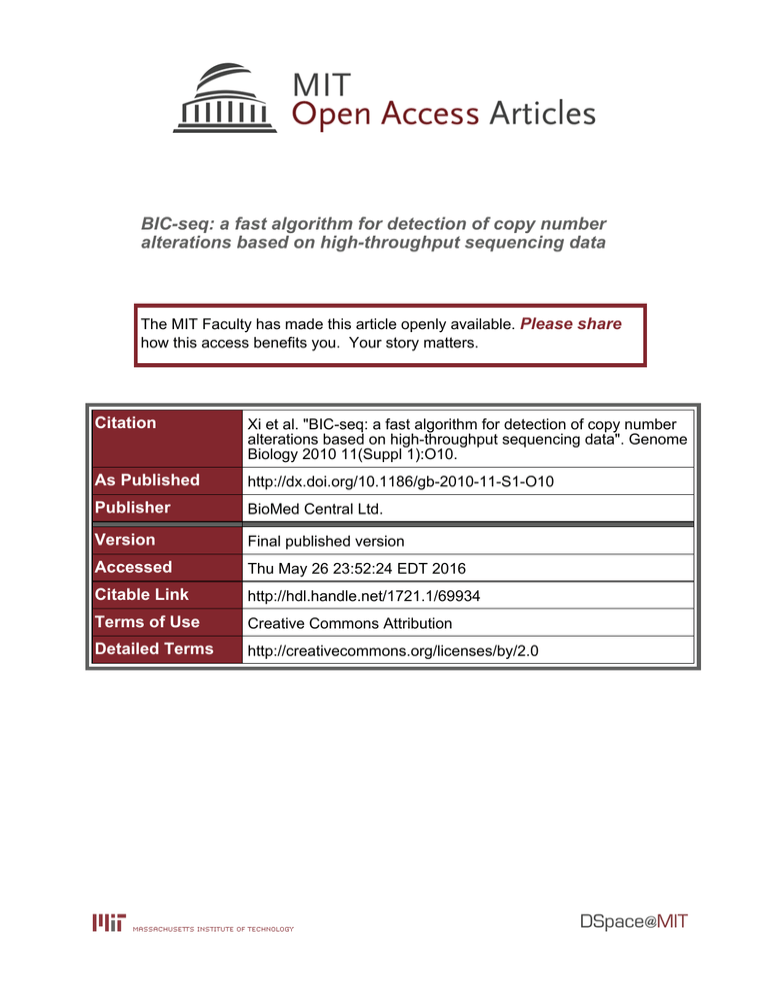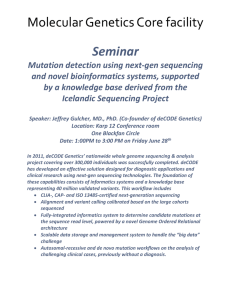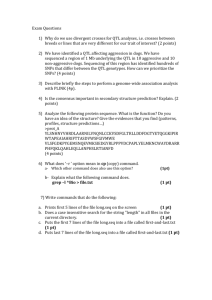BIC-seq: a fast algorithm for detection of copy number
advertisement

BIC-seq: a fast algorithm for detection of copy number alterations based on high-throughput sequencing data The MIT Faculty has made this article openly available. Please share how this access benefits you. Your story matters. Citation Xi et al. "BIC-seq: a fast algorithm for detection of copy number alterations based on high-throughput sequencing data". Genome Biology 2010 11(Suppl 1):O10. As Published http://dx.doi.org/10.1186/gb-2010-11-S1-O10 Publisher BioMed Central Ltd. Version Final published version Accessed Thu May 26 23:52:24 EDT 2016 Citable Link http://hdl.handle.net/1721.1/69934 Terms of Use Creative Commons Attribution Detailed Terms http://creativecommons.org/licenses/by/2.0 Xi et al. Genome Biology 2010, 11(Suppl 1):O10 http://genomebiology.com/2010/11/S1/O10 SELECTED ORAL PRESENTATION Open Access BIC-seq: a fast algorithm for detection of copy number alterations based on high-throughput sequencing data Ruibin Xi1, Joe Luquette1, Angela Hadjipanayis2, Tae-Min Kim1, Peter J Park1,3,4* From Beyond the Genome: The true gene count, human evolution and disease genomics Boston, MA, USA. 11-13 October 2010 DNA copy number alterations (CNA), which are amplifications and deletions of certain regions in the genome, play an important role in the pathogenesis of cancer and have been shown to be associated with other diseases such as autism, schizophrenia and obesity. Next-generation sequencing technologies provide an opportunity to identify CNA regions with unprecedented accuracy. We developed a CNA detection algorithm based on single-end whole-genome sequencing data for samples with matched controls. This algorithm, called BIC-seq, can accurately and efficiently identify the CNAs via minimizing the Bayesian information criterion (BIC). We applied BIC-seq on a glioblastoma multiforme (GBM) tumor genome from the Cancer Genome Atlas (TCGA) project and identified hundreds of CNVs, some were as small as 10 bp. We compared these CNAs with those detected using the array Comparative Genomic Hybridization (CGH) platforms and found that about one third were ‘missed’ by the array-CGH platforms, most of which were CNAs less than 10 kb. We selected 17 of the CNAs not detected by the array-based platforms for validation, ranging from 110 bp to 14 kb, and found that 15 of them are true CNAs. We further extended BIC-seq to the multi-sample case to identify recurrent CNAs in across multiple tumor genomes. Massachusetts 02115, USA. 4Harvard-MIT Health Sciences and Technology Informatics Program at Children’s Hospital, 300 Longwood Ave., Boston, Massachusetts 02115, USA. Published: 11 October 2010 Author details 1 Center for Biomedical Informatics, Harvard Medical School, 10 Shattuck St, Boston, Massachusetts 02115, USA. 2Harvard Medical School, 77 Louis Pasteur Avenue, Boston, Massachusetts 02115, USA. 3Department of Medicine, Brigham and Women’s Hospital, 77 Louis Pasteur Avenue, Boston, doi:10.1186/gb-2010-11-S1-O10 Cite this article as: Xi et al.: BIC-seq: a fast algorithm for detection of copy number alterations based on high-throughput sequencing data. Genome Biology 2010 11(Suppl 1):O10. Submit your next manuscript to BioMed Central and take full advantage of: • Convenient online submission • Thorough peer review • No space constraints or color figure charges • Immediate publication on acceptance • Inclusion in PubMed, CAS, Scopus and Google Scholar 1 Center for Biomedical Informatics, Harvard Medical School, 10 Shattuck St, Boston, Massachusetts 02115, USA Full list of author information is available at the end of the article © 2010 Park et al; licensee BioMed Central Ltd. • Research which is freely available for redistribution Submit your manuscript at www.biomedcentral.com/submit







